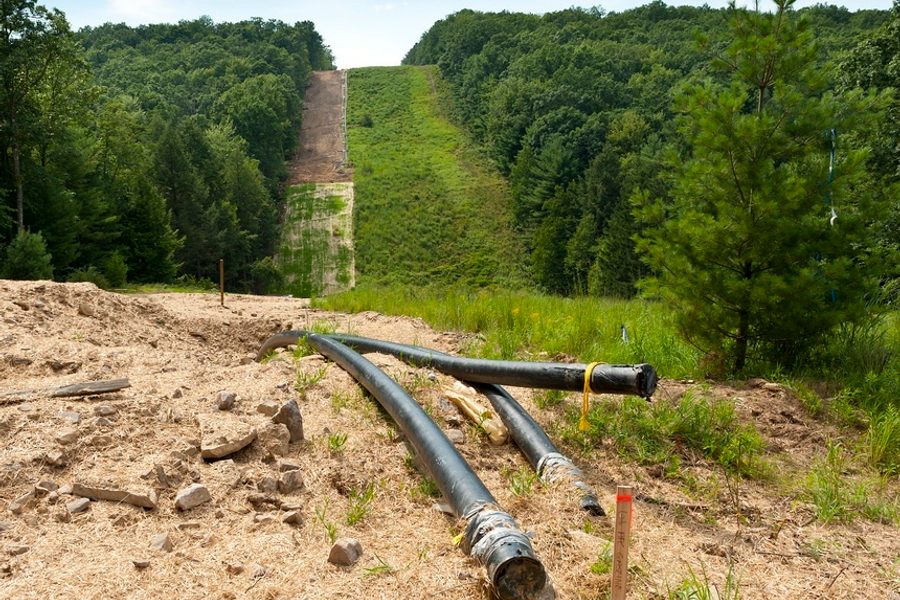Top Pipeline Regulator: Lack of Oversight ‘Keeps Me Up At Night’
Some 200,000 miles of gathering lines go entirely unregulated.
Cole Stangler

While the natural gas industry has long insisted that pipelines are a safe means of transportation, hundreds of accidents have punctuated the shale gas boom of the last five years.
Usually they’re not fatal: In 2013, there have been dozens of leaks and explosions on gas pipelines in sparsely populated areas — in rural Wyoming, Texas, Missouri, Louisiana and West Virginia, to name a few — without any loss of life. But such accidents in crowded areas can be deadly. In September 2010, a gas pipeline explosion in the San Francisco suburb of San Bruno killed eight, injured 58 and leveled several blocks. The following year, five people died in a similar explosion on a pipeline in Allentown, Pa.
Since most pipeline operators have to meet a bare minimum of safety requirements, critics have often charged the federal Pipeline and Hazardous Materials Safety Administration (PHMSA) with failing to properly oversee the hundreds of thousands of interstate pipelines that fall within its jurisdiction. It’s no secret that the small-budget agency based in the Department of Transportation — whose 151 inspectors are tasked with covering more than 2 million miles of pipeline across the country—has its fair share of troubles in fulfilling its regulatory mandate.
Help keep this reporting possible by making a donation today.
But while PHMSA has enough trouble looking after its existing jurisdiction, a high-ranking agency official recently expressed major concern about something that remains outside of her agency’s watch entirely. More than 200,000 miles of energy pipelines aren’t subject to any federal or state regulation at all: the so-called “gathering lines” that transport mostly gas, but some oil, directly from wells to processing sites.
“What keeps me up at night? Gathering lines,” Linda Daugherty, PHMSA’s deputy associate administrator for field operations, told a crowd of safety advocates at the Pipeline Safety Trust’s annual conference in New Orleans last month. “There’s a whole lot of gathering lines out there that no one is inspecting. There are no safety standards applicable to those lines, and no safety agency or regulator is looking at them.”
Unlike larger transmission pipelines, which typically transport oil and gas over long distances, and distribution lines, which deliver consumable energy to customers, federal regulations don’t apply to about 90 percent of the nation’s 240,000 miles of gathering lines.
That means that unless a state has its own regulations — and most of them don’t — nobody’s looking after the pipelines. What’s more, the lack of basic data-collection requirements at both the federal and state levels means that nobody knows exactly how many pipelines are out there.
“Overall, there’s no requirement to report accidents to PHMSA, so nobody really knows how many are occurring,” says Darin Burk, head of the National Association of Pipeline Safety Representatives and pipeline safety program manager at the Illinois Commerce Commission. “I personally have heard of one or two in this state over the years, but whether that’s all that’s happened, I couldn’t tell you.”
PHMSA regulates pipelines according to “class” — a category that’s largely determined by the number of buildings that fall within a 660 feet radius of the line. The roughly 10 percent of gathering lines that cross medium to high-density areas — classes 2, 3 and 4 — have to meet minimum safety requirements. But the 90 percent that fall under class 1 do not.
Although these unregulated lines are, in theory, traversing only rural areas, that’s not exactly a reassuring thought for the people living near them, especially in shale-rich parts of the country where contractors are hard at work installing more and more infrastructure to keep the gas flowing.
“They get to say in the event of an incident, it’s only forest or trees that will be affected, not the population,” says Meryl Solar, 60, a retired computer programmer living in New Milford, Pa., whose house sits about 2,000 feet from DTE Energy’s unregulated Bluestone Gathering Line. “I guess I’m just either a forest or a tree, so are my neighbors.”
The Bluestone is one of many new lines to be installed in the fracking hotbed of Susquehanna County, supplying gas from the Marcellus Shale to transmission lines in New York and the southern portion of the county. Although Pennsylvania is home to one of the richest shale formations in the nation, it’s one of many states that lacks gathering-line regulations: The law simply requires contractors and homeowners to notify the state before they start any digging or excavation projects. That means it’s up to residents like Solar to do the kind of basic safety oversight that one might typically expect of regulators.
Solar says she received a booklet from DTE Energy about how to take “shared responsibility” for the pipeline, such as detecting potential leaks. She says the pamphlet included an erroneous suggestion to be alert for strange odors (unprocessed natural gas is odorless). The booklet also urged her to be on the lookout for what the industry calls “third-party intrusions” — that is, any unauthorized guests or construction crews who might pose a threat to the pipeline’s integrity.
An accident waiting to happen?
The lack of oversight is of growing concern as the natural gas industry continues to expand. Of course, the more wells that are dug, the more gathering lines will be needed to transport the shale gas that’s extracted. Indeed the number of miles covered by such lines is expected to reach about 640,000 by 2035, according to the Interstate Natural Gas Association of America.
But the sheer growth in pipeline mileage isn’t the only safety concern.
Today’s gathering lines are larger and pumping gas at higher pressures than ever before. Traditionally, they were 2 to 12 inches in diameter. By contrast, today’s shale-bearing ones range anywhere from 12 to 36 inches and feature maximum allowable pressures that far exceed “historical operating parameters,” a PHMSA advisory committee found two years ago.
The Bluestone Line that runs by Solar’s house, for instance, ranges from 16 to 20 inches in diameter. On its website, DTE Energy boasts of the “high pressure” system that “has the ability to move a larger volume of gas through a single line.” It’s not just the Bluestone — whether it’s other drilling-intensive areas lying in the Marcellus Shale or further out West in North Dakota’s Bakken Shale, large high-pressure lines are the new norm.
They’re also encroaching into more populated zones.
“Over the years, the location of gathering lines has changed,” says Darin Burk. “They used to be pretty rural, non-populated, a lot of the time on private property. Well with the shale gas development, that’s changing. The gathering lines are starting to get into the more populated areas.”
What’s the hold-up?
While safety advocates may appreciate Daugherty’s candor about losing sleep over pipeline regulations, they’re also frustrated that her agency isn’t doing enough.
“I found it interesting that she made that comment,” Burk says with a laugh. “I tend to think that if it’s keeping you up at night, you should aggressively be going after it and trying to resolve the problem.”
Even the most basic federal oversight has proceeded at a snail’s pace. In 1992, Congress passed the Pipeline Safety Act, which gave PHMSA the authority to regulate gathering lines for the first time. But it wasn’t until 2006 that PHMSA actually published a rule that defined what a “gas gathering line” was — a decision it reached through extensive collaboration with the energy industry.
The charge that PHMSA is more of a friend to the oil and gas industry than a regulator is a familiar one. As one environmentalist recounted last month, “Employees have come to us and said, ‘We are a sleepy, industry-dominated organization.’ ”
Even so, one might have expected the Obama administration to usher in new oil and gas pipeline safety rules after the costly million-gallon spill in the Kalamazoo River in July 2010 and the San Bruno tragedy.
But efforts to draft an array of new pipeline regulations in the wake of these tragedies, which would make a flurry of improvements such as new leak detection requirements and better safety inspections, have ground to halt. Earlier this year, a high-ranking PHMSA official, Jeffrey Wiese, described the process as “kind of dying.”
Rulemaking on gathering lines has similarly stalled.
In August 2011, PHMSA issued an advanced notice of proposed rulemaking on gas lines that, among other things, asked for comment on whether to require all operators to disclose information about gathering lines and whether to extend regulations to cover all classes of lines. The comment period ended in January 2012, and the rule was supposed to reach to the office of Transportation Secretary Anthony Foxx by March 2013. But as of December 10, PHMSA still had not forwarded it to Foxx, according to PHMSA spokesperson Damon Hill.
“It’s still basically in the clearance process,” Hill says. “Those dates aren’t a definite date; they’re proposed dates.”
When asked what’s taking the agency so long, Hill says that the gas pipeline rule in question covers a variety of different topics and that the agency has to balance its competing concerns and “prioritize things.” PHMSA has dozens of congressional mandates, mostly housekeeping requirements and reports, from the 2011 Pipeline Safety Act, in addition to recommendations from the Government Accountability Office and Inspector General.
Political pressures have probably also driven the rule’s delay. Both Congress and the White House would likely prefer that PHMSA not undercut the mandates of the Pipeline Safety Act by preemptively issuing its own sweeping rules on gathering lines — and other topics. The agency is required to report to Congress by January 2014 on the “challenges of applying existing … regulations to gathering lines not subject to Federal regulation when compared to the public safety benefits” — sure to be a key indicator of where PHMSA stands on the issue right now.
Hill concedes that the timetable prescribed by the Pipeline Safety Act has “had an effect” on the delay of the pending rule on gas pipelines. He also declined to comment on any specifics of the stalled rule.
But if the energy industry has its way — not an unlikely prospect, given PHMSA’s institutional history — it’s hard to imagine a rule that simply extends existing safety regulations to all gathering lines. The American Petroleum Institute, the Independent Petroleum Association of America and Gas Processors Association are all opposed to extending those regulations before implementing basic data collection requirements. Since those basic data collection requirements would likely need to come first, an expansion of existing safety regulations is probably at least a couple years away.
In the meantime, PHMSA is encouraging states to pass their own regulations. Texas and Ohio, for example, recently passed new safety requirements on gathering lines. It remains unclear how many other shale-rich states will follow suit.
Solar, for one, isn’t too optimistic about the prospects of that happening in her state.
“They’ve pretty much dug up all of rural Pennsylvania,” she says. “In Pennsylvania, everything has been up to the industry to police themselves — whether it’s wellpads, whether it’s pipelines, whatever it is. … Our governor has handed over the keys of the state to the gas industry.”







